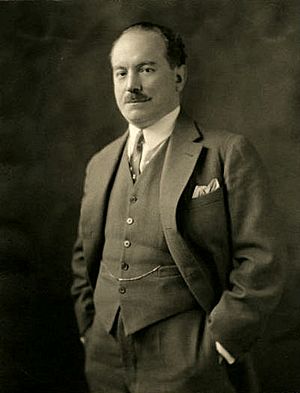Carlos Dávila facts for kids
Quick facts for kids
Carlos Dávila
|
|
|---|---|
 |
|
| Secretary General of the Organization of American States | |
| In office 1954 – October 19, 1955 |
|
| Preceded by | Alberto Lleras Camargo |
| Succeeded by | José Antonio Mora |
| Provisional President of Chile | |
| In office July 8, 1932 – September 13, 1932 |
|
| Preceded by | Himself (Junta government) |
| Succeeded by | Bartolomé Blanche |
| President of Government Junta of Chile | |
| In office June 16, 1932 – July 8, 1932 |
|
| Preceded by | Arturo Puga |
| Succeeded by | Himself (non-Junta government) |
| Personal details | |
| Born |
Carlos Gregorio Dávila Espinoza
September 15, 1887 Los Ángeles, Chile |
| Died | October 19, 1955 (aged 68) Washington D.C., United States |
| Political party | Socialist Party |
| Spouses |
Herminia Arrate
(m. 1929; died 1941)Frances Adams Moore
(m. 1950) |
Carlos Gregorio Dávila Espinoza (September 15, 1887 – October 19, 1955) was an important Chilean political leader. He was also a journalist and a diplomat.
Dávila led the Government Junta of Chile in 1932. Later, he became the secretary general of the Organization of American States (OAS). He held this international role from 1954 until he passed away in 1955.
Contents
Early Life and Education
Carlos Dávila was born in Los Ángeles, Chile. His parents were Luis Dávila and Emilia Espinoza. He finished his studies at the University of Santiago, Chile in 1907. At that time, the university was called the School of Arts and Crafts.
In 1911, he started studying law at the University of Chile. However, he left law school after three years. He chose instead to work for a newspaper.
Journalism Career
Carlos Dávila began his journalism career at El Mercurio newspaper in Santiago. He worked there until 1917. After that, he decided to start his own newspaper.
He founded La Nación in Santiago. He was the director of this newspaper until 1927. In 1932, he also started a Chilean magazine called Hoy.
Political and Diplomatic Roles
From 1927 to 1931, Dávila served as Chile's ambassador to the United States. This was a very important job. He represented his country in another nation.
He received special honorary degrees from two American universities. In 1929, Columbia University gave him an honorary LL.D.. The University of Southern California also gave him one in the same year.
Leading Chile in 1932
In 1932, Chile went through a time of political change. Carlos Dávila was part of the Government Junta. This group controlled Chile from June 4 to July 8, 1932.
From June 16, he served as the president of this Government Junta. On July 8, Dávila made a big decision. He ended the Government Junta and took power as the "Provisional President of Chile".
He then called for new elections for the country's congress. He was the provisional President until September 13, 1932. That year, six different people led Chile as President or head of the Government Junta.
International Work and Writing
After his time as president, Dávila continued his important work. In 1933, he was a visiting professor at the University of North Carolina at Chapel Hill. He taught international law there.
He also worked for the Editors Press Service in the United States. He wrote for many important South American newspapers. In 1941, he won the Maria Moors Cabot Award. This award recognized his excellent journalism that helped connect the Americas.
Carlos Dávila was a very active writer. In 1949, he published a book called "We of the Americas". He also wrote many articles about politics and economics for major American magazines.
Contributions to the OAS
Dávila played a key role in international organizations. From 1943 to 1946, he was on the Council of the United Nations Relief and Rehabilitation Administration. In 1940, he represented Chile on the Inter-American Financial and Economic Advisory Committee.
That same year, he created the "Dávila plan". This plan led to the creation of the Inter-American Development Commission. This commission later became part of the Organization of American States (OAS). The OAS was formed in 1948.
In 1946, he was a member of the United Nations Economic and Social Council. Because he helped create the OAS, he was chosen as its secretary general in August 1954.
Personal Life
Carlos Dávila's first wife was Herminia Arrate de Dávila. She passed away in Chile in 1941. Carlos Dávila then moved back to the United States with their two daughters, Luz and Paz.
In 1950, he married again. His second wife was Frances Adams Moore from Massachusetts. She was a widow and had a daughter named Dolly from her first marriage.
Carlos Dávila died on October 19, 1955. He had served as the secretary general of the Organization of American States for 14 months.
Images for kids
See also
 In Spanish: Carlos Dávila para niños
In Spanish: Carlos Dávila para niños


